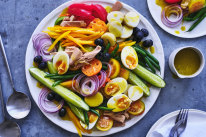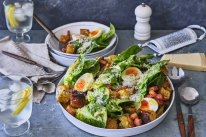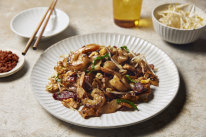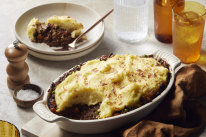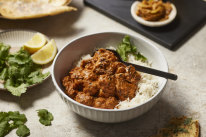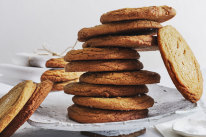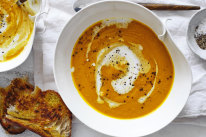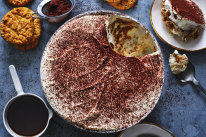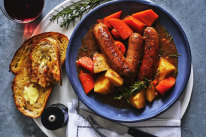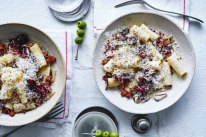Adam Liaw’s chicken cacciatore is the Italian-Aussie classic everyone needs in their repertoire
On the hunt for a dish all the family will love? Master Adam Liaw’s simple chicken cacciatore and you’ll never be stuck for ideas again.
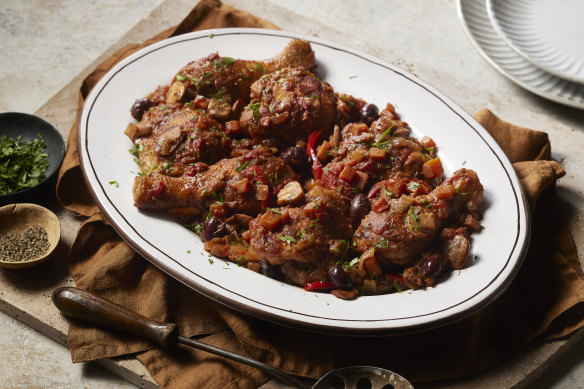
Italy’s iconic home-style “hunter’s chicken” is a family favourite around the country, and like most family favourites, there are many different ways to make it. Here’s my masterclass on how to make the right choices for a perfect chicken cacciatore.
Ingredients
4 chicken Marylands, skin on
3 tbsp plain flour
2 tbsp olive oil
1 large brown onion, peeled and diced
1 small carrot, diced
1 celery stalk, diced
3 garlic cloves, roughly chopped
salt and black pepper
1 red capsicum, sliced
150g button mushrooms, sliced
125ml red wine
400g can whole peeled tomatoes
250ml chicken stock
2 sprigs rosemary
½ cup kalamata olives
2 tbsp finely shredded parsley, to serve
sourdough bread or polenta, to serve
Method
Step 1
Separate the thighs from the drumsticks by cutting through the joint with a kitchen knife. Dust the chicken with flour and shake off any excess.
Step 2
Heat a wide, lidded casserole over medium heat and add the oil. Brown the chicken in batches, removing from the dish when browned. Add the onions, carrot, celery and garlic, season with a little salt and cook for about 8 minutes using any juices from the vegetables to scrape up any brown fond on the base of the pan. Add the capsicum and mushrooms and fry for a few minutes until softened. Add the wine and bring to a simmer for about a minute, then add the tomatoes and crush them a little. Add the stock, rosemary and season well with salt and black pepper.
Step 3
Return the chicken to the pot. Bring to a simmer, then cover with a lid and simmer for 30 minutes. Stir through the olives and simmer for a further 5-10 minutes uncovered, until the sauce is thick and coating the chicken. Allow to stand for 5 minutes before grinding over a little more black pepper and serving scattered with parsley. Serve with thick slices of sourdough or polenta.
Notes
What makes it “cacciatore”?
The only constants in just about every cacciatore recipe are meat (usually chicken or rabbit) and wine (either red or white).
Some recipes omit tomato, others omit soffritto (the “lightly fried” mixture of chopped onion, celery and carrot that forms the base of the stew), others still omit or vary the vegetables used, and the choice of herbs can be whatever you feel like.
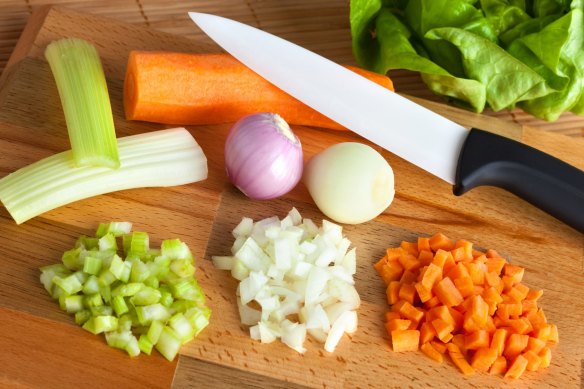
It’s hard to know how specific differences in traditional dishes become “part of the furniture”, so to speak. It’s possible that an influential Australian recipe source, such as Margaret Fulton or the Australian Women’s Weekly Test Kitchen published a cacciatore recipe back in the 1950s or ’60s that included capsicum, mushroom and olives, and those inclusions have simply stuck for Australian cooks.
These are by no means strange additions – mushrooms, particularly, are commonly added in Italian recipes. I simply note this because if you wanted to leave out the olives, use some white wine you had in place of the red specified, switch the rosemary for dried oregano from your pantry, or throw in some sun-dried tomatoes or marinated capsicums instead (which I often do), those changes are entirely fine.
Cooking on the bone
It’s often said that when cooking on the bone, the bone adds to the flavour, but that’s not quite the case. When making stocks or stews, the bones themselves do little for the flavour, although the breakdown of the collagen in the bones to gelatine can add “body” to the stock or stew. It’s actually the small amounts of meat attached to the bones, and the marrow contained within them, that improve the flavour.
For a stew, however, cooking on the bone really does keep the meat more flavourful, but not because the bone itself is adding flavour, as most people think.
As meat cooks, muscle fibres contract and physically squeeze out the juices from the meat – like wringing out a sponge. When attached to the bone, the muscles can’t contract as much, which allows the meat to retain more of its flavourful juices, resulting in more retained flavour and juiciness. It’s simple mechanics.
Cacciatore is traditionally made with a whole chicken cut into pieces. I prefer the taste and texture of the leg and thigh over breast meat, so I make this with marylands, a cut that includes both drumstick and thigh, with the skin on. If you can’t find marylands, I’d recommend using drumsticks.
Flouring
Flouring meat or poultry before cooking in a stew has three main purposes.
Firstly, a small amount of flour can assist browning and increase flavour by producing more Maillard reactions between sugars and proteins from the flour, and proteins from the meat. But using too much flour creates a physical barrier between the meat and the pan and can actually stop the meat from browning effectively, which can reduce flavour. This is why it’s important to shake off as much excess flour as you can before frying. I sometimes even flour meats by dipping a pastry brush into flour and dusting the meat as if dusting for fingerprints to make sure I’m not flouring too much.
The second purpose of flouring is to create a coating on the meat that can absorb the flavour of the stew. This coating isn’t as thick as a batter but even a tiny amount of flour on the surface will help the flavour of the liquid stick to the meat. It’s the same principle as using a small amount of starch to marinate meats when stir-frying.
Lastly, the flour (or more specifically, the starch within it) thickens the liquid in the stew, giving it a richer and more satisfying texture.
Pot choice and liquid management
I don’t usually like to specify the size, shape or material of pan or pot when I write a recipe, but that doesn’t mean it’s not important. It’s actually crucial, but a recipe writer needs to be pragmatic, and not everyone will have every piece of specified equipment at their disposal.
When choosing the appropriate pot for a dish, the main thing you should consider is liquid management, and to do that you need to think about the relationship between the surface area of a pot and its volume.
A taller, thinner pot will have a lower ratio of surface area to volume while a lower, wider pot will have a higher ratio. This means that liquid will evaporate from the taller pot than the lower one. A taller, thinner pot will have a lower ratio of surface area to volume while a lower, wider pot will have a higher ratio. This means that liquid will evaporate more slowly from the taller pot than from the wider one.
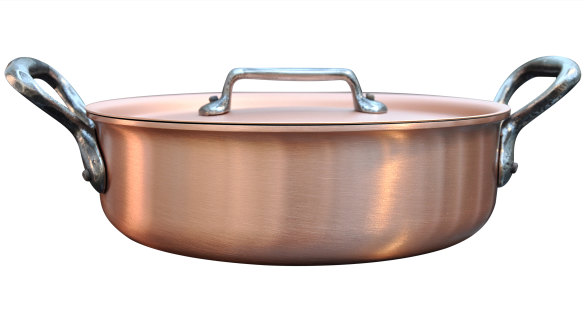
For a dish that cooks for a long time – like a three-hour bolognese – you don’t want the liquid to evaporate too quickly. More liquid allows you to cook more evenly, and reduces the risk of burning. For a dish that cooks for a shorter time, a wider dish will allow you to evaporate liquid more quickly to concentrate flavour simply by covering or removing the lid.
This cacciatore only simmers for about 45 minutes, so a low, wide casserole dish is perfect for giving you space to brown the chicken and cook the soffritto, as well as providing the surface area that will allow evaporation to thicken the stew quickly without overcooking the chicken.
Appears in these collections
The best recipes from Australia's leading chefs straight to your inbox.
Sign up- More:
- Masterclass
- Chicken
- Carrot
- Onion & leek
- Mushrooms
- Tomato
- Olives
- Dairy-free
- Egg-free
- Nut-free
- Italian
- Casseroles & braises
- Main course
- Dinner party
- Family meals
- Comfort food
- Kid-friendly
- One-pot

